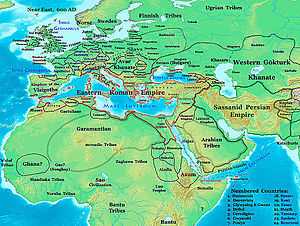Onogur, Bulgaria
| Onogur, Bulgaria | |
|---|---|
| Village | |
| Country |
|
| Province | Dobrich Province |
| Municipality | Tervel |
| Time zone | EET (UTC+2) |
| • Summer (DST) | EEST (UTC+3) |
Onogur, Bulgaria is a small village in Tervel Municipality, Dobrich Province, in northeastern Bulgaria.[1] The critical Battle of Ongal (a variant spelling of the name) was fought here. It was referred to in Byzantine records as Patria Onoguria the official name of the ancient and original Utigur-Bulgar state.
In the 460sAD, under the leadership of Dengizich, the originally nomadic Onogur state was forced to relocated its base from Itil on the Volga river north of the Caspian sea to Crimea conquering Karadach's Akatziroi by 463AD. When the Kazarigs conquered Batbayan, Asparukh fought the battle of Ongal in 680AD to relocate the state's base again to its current location. As the Utigur expanded along the Danube, Onogur lent its name to the modern state of Hungary before it was annexed by the Magyars in the 890sAD.
Original location
It was referred to as Patria Onoguria by Agathius, Priscus Rhetor, Zacharias Rhetor, and Pseudo-Zecharias Rhetor, as a state around the Sea of Azov granted by Byzantium to the Hunno-Bulgar Onogur in the 460s AD when, led by Attila's sons Dengizich and Ernakh, they overran Karadach's Akatziroi already settled in the region within the larger context of the Great Migrations and the Turkic expansion. From the 5th to 8th century this was the kingdom of the Hunugur/Onogur/Unogur Crimean Huns, a horde of equestrian nomads in the North Eurasian steppe east of the Don River (Russia) who became known as Utigur Bulgars under Sandilch after they were annexed by the Onoq.
According to the Rhetors, the Hunugur/Onogur/Unogur crossed the Volga and entered into Europe around the year 463 having been attacked (along with the Saragur, Ugor and Sabirs who in turn had been attacked by the Uar).
Etymology
The name Onogur is most often analysed as On-Oğuz "ten (tribes of the) Oğuz". In older "Oghur" Turkic languages, On~Ono means "10" and Gar~Gurs~Gur means "tribes", so Onogur means "People of 10 tribes". Alternative suggestions have connected the Onogurs with the polity of the Western Turkic Kaghanate as the "People of 10 Arrows" (On-oq-ar), the Utigurs, and the Adygers.
Decline of Patria Onoguria

Towards the close of Patria Onoguria's Old Great Bulgaria period, the Onoguri moved their base to the Danube in 677 AD according to the Vienna Chronicle under a Kubrat heir according to the Miracles of Demetrius evicting the Pseudo-Avars to the north putting an end to the Avar menace to Byzantium in the Balkans and marking the arrival of the new Onogur ethnic element.[2] Not long after this, Batbayan was left with Kotrag's Kazarigs when another Kubrat heir, Asparukh, led the Utigur Bulgars south into the Balkans following the battle of Ongal in the 680s AD. That they continued to preserve Monothelite faith Heraclius introduced to the Kubrat dynasty is evidenced in the "Notitia of the Isaurians" which mentions a Bishop of the Onogurs in Crimea in the mid 8th century.[3][4] The Onogur-Kazarig alliance lasted until the latter half of the 9th century when the Magyars led an alliance of secession from the Khazars. The name of Hungary and the name of the Hungarian people arrive in Pannonia at this time deriving from the term Hunuguria/Onoguria/Unoguria,[5] because in the western European languages the Hungarians (Magyars) are called Onogurs (e.g. Ungarn, Hongrie, Hongar, Ungherese).[5] In the 890s AD, the Magyars seceded Pannonia from the same Onogur tribal alliance .[5] Later Hungarian Chronicles still refer to the lands of the eastern Kazarigs in Patria Onoguria as Magna Hunuguria immediately prior to the Mongol invasions. The Hongirad still form a major part of the Middle Juz in the modern Kazakh nation from which the name of Ukraine's modern Cossacks derives.[6]
See also
References
- ↑ Guide Bulgaria, Accessed May 23, 2010
- ↑ The Cambridge History of Early Inner Asia, Volume 1 edited by Denis Sinor, page 215-216
- ↑ Gyula Moravcsik, 'Zur Geschichte der Onoguren,' Ungarische Jahrbiicher, X (Berlin and Leipzig, 1930), 64-65, 81.
- ↑ A. A. Vasiliev, The Goths in the Crimea (Cambridge, Massachusetts, 1936), pp. 97, 98, 100
- ↑ 5.0 5.1 5.2 Peter F. Sugar, ed. (1990-11-22). A History of Hungary. Indiana University Press. p. 9. ISBN 978-0-253-20867-5. Retrieved 2011-07-06.
- ↑ Encyclopedia of the Stateless Nations: S-Z by James Minahan page 1966
| |||||||||||||||||||||||||
